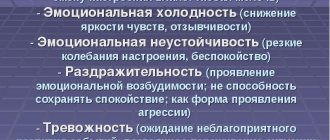Dementia is an acquired dementia that is characterized by pathological processes in the brain. A person with dementia loses the knowledge and skills they have already acquired and cannot further explore the world. Dementia in most cases occurs in old age and is called “senile insanity.” However, there are frequent cases of the development of pathology (mental retardation, mental retardation, cognitive impairment, etc.) in childhood. In Moscow, experienced specialists from the Yusupov Hospital will diagnose and select the optimal therapy for dementia, where an integrated approach is provided to the treatment of patients over 18 years of age.
Mentally retarded children. Oligophrenia.
The causes of mental retardation can be both external and internal. Doctors identify the most common ones:
- intoxication of the body of a pregnant mother or fetus;
- hereditary incompatibility of Rh blood between a child and a woman;
- parasites that infect the fetus, passing from the mother’s body;
- changes in internal organs caused by dystrophy during pregnancy;
- an inflammatory process that occurs in the child’s brain;
- injury to the fetus during childbirth;
- serious physical and mental injuries that occurred during infancy;
- negative environmental situation;
- impaired metabolism;
- pregnant women using drugs and alcohol;
- poor infant nutrition.
A Rh conflict can cause the development of serious abnormalities in a baby.
Somatically, an oligophrenic child is practically healthy. Oligophrenia is not a disease, but a condition of a child in which there is persistent underdevelopment of his entire psyche.
Underdevelopment of the cognitive and emotional-volitional sphere in oligophrenics is manifested not only in a lag behind the norm, but also in deep originality. They are capable of development, although it occurs slowly, atypically, sometimes with sharp deviations. However, this is genuine development, during which both quantitative and qualitative changes occur in the child’s entire mental activity.
Mental retardation that occurs after the child’s speech has already formed is relatively rare. One of its varieties is dementia. As a rule, the intellectual defect in dementia is irreversible, as the disease progresses, which can sometimes lead to complete collapse of the psyche.
In Russian defectology, mentally retarded children are usually divided into three groups: morons, imbeciles, idiots. Morons are children with mild degrees of mental retardation. They are the main contingent of special kindergartens and special schools for mentally retarded students. Children with moderate and severe retardation (imbeciles and idiots, respectively) live and are raised in families or are placed in boarding institutions of the Ministry of Social Protection, where they remain for life.
Children with organic lesions of the cerebral cortex (oligophrenic) usually grow up weakened, nervous, and irritable. Many of them suffer from enuresis. They are characterized by pathological inertia of basic nervous processes, lack of interest in the environment and therefore emotional contact with adults, the need to communicate with them in a child of preschool age often does not arise.
Children do not know how to communicate with their peers. Their spontaneity in assimilating social experience is sharply reduced. Children do not know how to act correctly either according to verbal instructions, or even according to imitation and model. In mentally retarded preschoolers, situational understanding of speech can be maintained until they enter school.
In order to master methods of orientation in the surrounding world, to impart and fix clearly defined properties and the simplest relationships between objects, to understand the importance of a particular action, a mentally retarded preschooler requires much more variable repetitions than a normally developing child.
In mentally retarded children - preschoolers, deprived of special correctional education, there is a significant underdevelopment of activities specific to this age - playing, drawing, designing, and basic household work.
A mentally retarded child shows extremely little interest in his surroundings, does not reach for toys for a long time, does not bring them closer to himself and does not try to manipulate them. At the age of 3-4 years, when normally developing children actively and purposefully imitate the actions of adults, mentally retarded preschoolers are just beginning to get acquainted with toys. The first object-based play actions appear in them (without special training) only in the middle of preschool age.
For the majority of mentally retarded children who do not attend a special kindergarten, who do not have contact at home with defectologists or caring and reasonable parents, graphic activity until the end of preschool age is at the level of aimless, short-term, chaotic scribbling.
Sensory development in preschool and school age in these children lags significantly behind in terms of development. They act either chaotically, without taking into account the properties of objects, or in a previously learned way that is not adequate in a new situation. The perception of oligophrenics is characterized by undifferentiation and narrowness. All mentally retarded children have deviations in speech activity, which can be corrected to one degree or another.
The development of speech hearing occurs in mentally retarded children with great delay and deviations. As a result, they experience the absence or late appearance of babbling. Oligophrenics are characterized by a delay in the development of speech, which is revealed in a later (than normal) understanding of speech addressed to them and in defects in the independent use of it. Some mentally retarded children experience a lack of speech even by the age of 4-5 years.
Great difficulties arise for a mentally retarded child when solving problems that require visual-figurative thinking, that is, acting in the mind, operating with images of ideas. Mentally retarded preschoolers often perceive the images in the picture as a real situation in which they are trying to act.
Their memory is characterized by a small volume, low accuracy and strength of memorized verbal and visual material. Mentally retarded children usually use involuntary memorization, that is, they remember bright, unusual things that attract them. Voluntary memorization is formed in them much later - at the end of the preschool, at the beginning of the school period of life.
There is a weakness in the development of volitional processes. These children are often lacking initiative, lack of independence, impulsiveness, and it is difficult for them to resist the will of another person. They are characterized by emotional immaturity, insufficient differentiation and instability of feelings, a limited range of experiences, and extreme manifestations of joy, grief, and fun.
When raising a mentally retarded child in a family, parents should think about his future. If it is assumed that he will spend his entire life only in the family, without working anywhere, then it is enough for him to have self-service skills and basic household work. If other prospects arise, then the mentally retarded child must be prepared for them in advance.
Prevalence of the disease and its causes
| Form | Symptoms |
| Mild degree or debility |
|
| Moderate – imbecility | |
| Severe form of imbecility |
|
| Deep degree or idiocy |
|
Dementia occurs not only in older people, but also in children. According to medical statistics, the level of childhood dementia in Russia is 1.64%.
For comparison: in Canada this figure is 1.12%, in Finland 1.19%, in the USA 1.2%, in Australia 1.43%, in China 1.71%.
Childhood dementia can be congenital or acquired. Its main reasons are:
- infectious diseases suffered by a woman during pregnancy;
- premature birth;
- asphyxia and injuries received during childbirth;
- social and pedagogical neglect at an early age;
- genetic diseases;
- traumatic brain injuries, bruises and concussions;
- encephalitis, meningitis, human immunodeficiency virus (HIV);
- disturbance of vascular blood flow and insufficient nutrition of brain tissue.
Solving this complex problem requires the help of qualified specialists and comprehensive diagnostics of the whole organism.
Dementia in children and adults: what kind of disease is it?
When cognitive abilities deteriorate, it becomes difficult to perceive new information, and childhood dementia develops. A decrease in intelligence is observed in adult patients more often than in young ones. High education, a developed brain, complex and diverse abilities determine the individuality of a real person.
But various diseases, injuries, stress and bad habits can damage brain neurons. In this case, a person may lose a certain part of his professional skills, knowledge and practical experience.
How does mental retardation manifest?
Compiling a clinical picture showing the development of a mentally retarded child, experts note that mental retardation is closely related to mental disorders. It manifests itself as disturbances in speech, emotions, generalizations, conscious activity, and knowledge of the surrounding world. Characteristic symptoms in the development of a mentally retarded child occur at different periods of his life.
Newly born children with mental retardation differ from healthy children in external signs and internal pathologies. Characteristic features:
- abnormal structure of the body, head, face;
- pathology of various internal organs;
- phenylketonuria: sour odor emanating from the newborn and his urine, pale skin, convulsions, light blue tint of the cornea, muscle weakness, lack of simple reactions.
As the year approaches, the symptoms of the disease become more severe. Mental retardation results in the following symptoms:
- the baby cannot hold his head;
- there is no baby babble, which is usual for this age, indicating the development of speech skills;
- muscle weakness is expressed in the child’s inability to crawl, sit, or stand up independently.
If a child does not begin to hold his head in infancy, this is a very alarming signal.
Preschool age
The preschool period clearly reveals serious deviations in the behavior of mentally retarded children. Oligophrenia affects all areas of life and manifests itself in the following symptoms:
- incoherent, late-onset speech;
- motor impairment;
- scattered, unstable attention;
- behavioral disorders;
- poor physical development;
- emotional instability;
- inability to self-care (inability to brush teeth, tie shoelaces, get dressed) (see also: how to teach a child to tie shoelaces quickly and easily?).
School age
Difficulty completing routine tasks
The appearance of difficulties in performing familiar tasks may be an early sign of the onset of dementia. As a rule, it all starts with the fact that a person cannot perform complex tasks: check the balance of a credit card or remember the rules of a game. Additionally, you may notice that a person nearing retirement age has a hard time doing new things or following new rules.
Make your meetings with loved ones regular: 3 steps to mental health
Game of Thrones continues. Martin will soon release a sequel to The Winds of Winter
Segur-le-Chateau: a 10th-century fortress is rightfully considered the most beautiful corner of France
Types and forms
ICD-10 identifies four degrees of mental retardation in children and adolescents: mild, moderate, severe and profound.
In accordance with this classification, classical psychiatry distinguishes four degrees of dementia: debility, mild imbecility, severe imbecility and idiocy.
| IQ level | Degree of mental retardation according to ICD-10 | Classification in classical psychiatry | Mental age, years |
| 50-69 | Lightweight | Moronism | 9-12 |
| 35-49 | Moderate | Imbecility is not pronounced | 6-9 |
| 20-34 | Heavy | Severe imbecility | 3-6 |
| Up to 20 | Deep | Idiocy | Until 3 |
- Morons. Able to carry out simple buildings with guidance. Their speech and motor functions are slightly impaired, so they experience difficulties when communicating with peers.
- Imbeciles. They are not adapted to independent life. They are trained in defectological institutions. Over time, they learn to perform simple tasks.
- Idiots. Not trainable. Sometimes they have the rudiments of speech. Eating, dressing, and performing hygiene procedures can only be done with the help and under the supervision of outsiders.
Dementia in children and adolescents can be residual organic or progressive:
- The residual organic form is caused by residual brain damage as a result of traumatic brain injury, meningitis, and drug poisoning of the nervous system. This form of dementia does not progress and is stable, without further worsening of symptoms.
- Progressive dementia develops due to vascular lesions of the brain, genetic diseases and diseases of the spinal cord. This form is characterized by a gradual increase in symptoms of dementia.
Changes in mood
This is a common sign of dementia. It is not always easy to notice this sign in yourself, but it is easy to recognize it in loved ones. For example, depression is a common condition in dementia praecox.
Along with changes in mood, personality changes can also be seen. One typical type of change is moving away from shyness. This happens because self-criticism is often one of the first to suffer.
Characteristics of a sick child
Developmental defects of a mentally retarded child affect all parameters of the individual and the person as a whole. Organic defects result in diseases such as hydrocephalus and cerebral palsy. Intellectual disabilities are associated with damage to certain cortical brain processes. Difficulties with cognitive activity take on different forms, leading to the impossibility of learning for mentally retarded children. Physiological disorders lead to decreased vision, hearing, and underdeveloped speech.
Psychology defines three criteria:
- clinical – associated with organic brain damage;
- psychological – expressed in disorders of cognitive activity;
- pedagogical – indicates a low level of learning ability.
Problems of perception
Slow perception, characteristic of the behavior of patients with oligophrenia, does not allow the child to correctly evaluate the objects around him; a lot of time is spent recognizing a familiar thing, and it is not possible to connect different objects with each other. A sick child confuses similar-sounding words and does not distinguish numbers, letters, or objects from graphic representations.
The perception of the information received occurs in an incomplete volume. It is difficult for kids to analyze and describe the image they see. Having memorized one subject, they do not strive to independently learn other things; they need to be pushed to action. It is impossible to educate mentally retarded children in a regular school.
A child with such a deviation does not understand the simplest things and cannot attend a regular school.
Understanding the world should occur in stages, but in sick children this mechanism is disrupted. There is no systematic analysis of objects; the baby is hardly able to notice the connection between parts of the whole. Such absent-mindedness leads to the loss of the initial idea of the thing he is studying. Weak mental activity prevents you from correctly assessing your actions and actions.
Delays in speech and mental functions represent serious differences between sick children and normal children. Sick children have great difficulty mastering writing and reading, they are inattentive, and cannot bring what they start to the required competent completion.
Underdevelopment, as psychology shows, is also noticeable in emotional terms. Children do not outwardly show their feelings, their volitional mechanisms do not work well, and their activity is poorly developed. They lag behind in physical development, being delayed in mastering basic skills: they begin to crawl, hold their head up, and walk poorly and late.
A three-year-old sick child does not know how to express himself as a person. The play activity of a preschooler consists of primitive actions with objects. In addition, patients with oligophrenia cannot take care of themselves; they require constant assistance from adults.
The games of such children, even at school age, remain very primitive
Symptoms of childhood dementia
The first signs of the development of mental retardation are a delay in the growth of intelligence, lack of self-care skills, and behavior unusual for age. In children with mild retardation, symptoms may not appear until the child reaches preschool age. In children with moderate and severe developmental delays, developmental delay is diagnosed at an early age. Most often it is a consequence of pathologies such as physical abnormalities, developmental defects, and cerebral palsy.
In school-age children, mental retardation is manifested by a low IQ level combined with impaired behavioral skills.
In some cases, delayed intellectual development is accompanied by motor disorders, delayed speech development and hearing impairment.
As the child grows, psychological disorders, apathy, depression and anxiety may arise due to the awareness of his failure in society.
Diagnosis of mental retardation
Mental retardation is diagnosed based on an assessment of psychological development and intelligence using special tests. Such tests are carried out exclusively by a qualified psychologist. If a child is suspected of having mental retardation, a number of diagnostic measures are carried out, including computed tomography and magnetic resonance imaging.
Symptoms and signs of dementia in children and adolescents vary depending on the underlying cause of the disease and the severity of its progression.
The first sign of dementia in young children and preschoolers is the persistent loss of skills that were previously learned and easily practiced.
We can talk about mental retardation if the child:
- later peers begin to walk and talk;
- forgets words, constructs sentences incorrectly;
- looks unkempt, does not care about his appearance;
- feels indifference to the outside world;
- loses affection for loved ones.
The baby's movements become disinhibited, and high spirits prevail. With further development of the disease, the child’s movements become less differentiated and more uniform.
If in preschool age it is quite difficult to recognize mild dementia, then during school years the disease manifests itself more confidently:
- the student has difficulty learning new material;
- writes and reads slowly, cannot solve logic problems;
- does not understand the meaning of proverbs and sayings;
- cannot reproduce the content of the text just read;
- forgets words, has difficulty constructing sentences;
- reacts inappropriately to the words and actions of others;
- gets tired quickly, often feels apathy and lethargy.
Previously acquired skills and speech are retained for a long time, but memory works selectively. For example, a preschooler can name the days of the week and the sequence of seasons in order, but confuse the colors.
What are the symptoms of dementia at 15? At this age, dementia can be recognized by the following signs:
- the child does not assimilate social and legal norms;
- does not take care of himself, looks untidy;
- loses interest in hobbies and previously favorite activities;
- begins to obsessively collect unnecessary things;
- all his games become monotonous, with constantly repeating actions;
- does not remember information well, thinks superficially, and has problems doing homework.
A mild form of mental retardation (another name for debility) is that the patient’s IQ ranges from fifty to sixty-nine. In appearance, such children are practically no different from other children. Basically, they experience difficulty in learning, since their concentration is greatly reduced.
Moreover, such children have a fairly accurate and good memory. Often children with a mild form of retardation have some behavioral disturbances. They are dependent on their parents and educators, they really don’t like them. Such children have difficulty communicating, they do not recognize the emotions of other people well and become withdrawn.
With an average form of mental retardation (another name for imbecility), the IQ is thirty-five to forty-nine. Such children experience affection and distinguish between punishment and praise. They can be taught basic self-care skills. They can learn writing, reading, and basic arithmetic. But they cannot live on their own and constantly need care and control.
Severe form of mental retardation (idiocy). The IQ of such children is below thirty-four. It is impossible to teach such patients anything. They have no speech, their movements are undirected and clumsy. Emotions are limited to the simplest manifestations of dissatisfaction and satisfaction. Children with this form of mental retardation need constant monitoring and supervision; they are kept in special institutions.
In childhood and infancy, oligophrenia can manifest itself in delayed development of the child, which can be identified after a timely visit to the pediatrician. In kindergartens, sick children may have problems mastering classes; adaptation to a group of other children is problematic. Children with mental retardation find it difficult to maintain a daily routine.
Mental retardation has the following symptoms, which may worsen depending on the severity of the disease:
- decreased intellectual development;
- complex functions of thinking, such as generalization, establishing cause-and-effect relationships, are underdeveloped;
- general systemic underdevelopment of speech, which is manifested by late speech, delay in the development of phrasal speech, significant difficulties in learning to write and read;
- attention is impaired;
- perception is impaired;
- inability to think critically, underdeveloped or absent abstract thinking;
- memory has low productivity;
- low activity in cognition;
- the emotional-volitional sphere is disturbed.
Symptoms of dementia in adults
During the asthenic form of oligophrenia, the following signs appear:
- Fatigue, weakness;
- Emotional instability;
- Impaired consciousness, attention;
- Mental imbalance.
For atonic dementia:
- Unreasonable and unstable behavior.
During sthenic dementia:
- Imbalance, hot temper;
- Impaired mental reaction;
- Inappropriate behavior.
Dysphoric stage:
- Unreasonable mood swings;
- Aggressive behavior.
Moreover, absolutely all people who are diagnosed with “moronism” have a mental disorder. Of course, this factor will affect the social adaptation in society of both children and adults. Patients with debilitation have difficulty building relationships with other people, learning, and can only work in the simplest jobs.
Methods for diagnosing the disease
When the first signs of dementia appear, the child should be shown to a qualified neurologist, who will assess the neuropsychic state of the young patient and take a history of his illness.
Upon referral from a neurologist, the child will have to undergo testing in a psychologist’s office, as well as laboratory and instrumental examination.
To identify mental retardation, the following types of psychological tests are used:
- Eysenck test - shows the mental age and intelligence quotient (IQ) of the patient.
- Stanford-Binet Intelligence Scale - assesses the mental development of children aged 6 to 16 years.
- The Wechsler test assesses the intelligence of children aged 2.5 to 7.5 years.
- Benton's visual retention test - identifies organic brain damage and its severity.
If dementia is suspected, the child is prescribed a laboratory blood test for glucose, thyroid hormones, vitamin B12, syphilis, ALT and AST.
A general blood test can detect the presence of infectious processes in the body, and a biochemical screening can be used to assess the functional state of the kidneys and the level of electrolytes in the blood.
- Magnetic resonance imaging (MRI) provides valuable information about malformations of the central nervous system, structural changes in the brain and various organic disorders.
- A computed tomography (CT) scan involves examining the physical structure of the brain using X-rays. Allows you to identify the presence of scars and injured areas in the brain, which may be the cause of the child’s mental disability.
- An electroencephalogram (EEG) allows you to assess the functional state of brain structures during wakefulness, sleep, active mental or physical work.
Fluctuations in alpha, theta and delta waves indicate acquired dementia syndrome and delayed psychomotor development in a child.
It is possible to determine whether there is mental retardation at the age when the child begins to develop speech and motor skills. Specialists carefully approach the examination so that the diagnosis is as accurate as possible and cannot negatively affect the future of the little man. A full conclusion on the type of illness is given only by the age of 3, since a decrease in intelligence is not always associated with mental retardation.
Determination of mental retardation is carried out at an older age - closer to 3 years and older
Diagnosis is carried out by psychologists and psychiatrists. Special tests have been developed aimed at determining the level of development and establishing intellectual abilities. When drawing conclusions on mental retardation, experts take into account factors such as lack of motor function, the presence of a language barrier, cultural characteristics, disorders associated with vision, speech, hearing, and illnesses suffered in infancy.
The disease can cause additional mental disorders and somatic ailments that affect the behavior of mentally retarded children. Mentally retarded children are diagnosed based on standard tests and disease-specific symptoms. Having discovered an illness, the doctor is obliged to find out its causes in order to build a prognosis for the dynamics of the child’s development. Parents may be given training programs and advice on behavior and communication.
Understanding the responsibility that falls on a woman when carrying a fetus, the expectant mother is obliged to regularly attend antenatal clinics, eliminate bad habits, and be careful in everyday life. When planning a pregnancy, it would be useful to find out whether there were cases of oligophrenia in your family. It is necessary to find out the risk of having a sick child. Prevention of retardation consists of timely vaccination against infectious diseases and constant monitoring by a pediatrician.
The degree of mental retardation is most often assessed using standardized tests that determine the patient's condition. It must be taken into account that IQ is one of the important, but far from the only criterion indicating mental retardation.
In addition to IQ, the doctor needs to assess the patient’s everyday skills, his mental state, previous illnesses, as well as the level of social adaptation.
It is also necessary to understand that children with mental trauma often display a lower level of intellectual development than they actually have. This phenomenon is explained by an unstable emotional state that suppresses other mental functions.
The testing and examination procedure itself is stressful, and this aggravates the detection of pathology. Before diagnosing an illness, it is worth carrying out psychotherapeutic work with the child, which will stabilize the psychological state.
One of the important factors that should not be overlooked when working with a child with mental retardation is overdiagnosis. Most often this affects children who are deprived of parental care and have experience living in special institutions.
In the process of working with such children, specialists may encounter a case when correctly structured correctional and developmental work with a child shows results at a level of development that exceeds those established by the diagnosis.
Diagnosis of dementia in a child
Complete information about the birth and pregnancy of the mother, collection of anamnesis (including family history), assessment of the general and physiological development of the child - this is the basis on which the diagnosis of dementia in children is based.
But child psychiatrists note that it is quite difficult to identify oligophrenia in children of preschool and early age (if, of course, this is an implicitly expressed sign): determining the level of mental abilities according to Wechsler for preschoolers (according to WAIS) is designed for children five years old or more, find out the level communication skills and adaptive behavior using a specially created rating scale is also quite difficult. All that remains is to test your ability to add cubes and vocabulary.
Therefore, determining mental development (in addition to severe idiocy and imbecility) can be complicated, but at the same time, a specialist needs to diagnose the symptoms (often nonspecific) as clearly as possible and determine the relationship of the clinical picture with the cause of mental retardation.
Blood tests sometimes help with this - biochemical, general, RW, AntiHSV-IgM, enzymes, CMV (cytomegalovirus) and toxoplasma, genetic research, urine analysis for amino acids , etc. And only instrumental examination of the brain - MRI, CT and encephalography - will be able to determine the presence of craniocerebral disorders.
The correct diagnosis of pathology of mental development can be ensured by a differential examination, since many diseases and conditions (schizophrenia, epilepsy, etc.) partially have similar neuropsychiatric symptoms.
In most countries around the world, the definition of dementia in children is made according to the American Psychiatric Association (APA) Statistical and Diagnostic Manual of mental disorders (DSM), and is based on three main factors: evidence that mental development limitations became apparent in adolescence or childhood, significant limitations in one or more areas of adaptive behavior and deficits in general mental abilities.
Treatment tactics
Symptomatic therapy can prevent further weakening of intelligence and maintain its existing level.
For the symptomatic treatment of dementia, antipsychotics, anticonvulsants, tonics, vitamins and biogenic stimulants are used.
Neuroleptics
If a small patient suffers from tension, aggression, a pronounced feeling of fear, mental disinhibition, mood swings, apathy, lethargy or poor sleep, he is prescribed antipsychotics Azaleptin, Clozapine, Nootropil, Noocetam, Olanzapine, Piracetam, Reserpine, Cerebrolysin, etc.
For convulsions, the child is prescribed anticonvulsants, which reduce hyperkinesis, contribute to partial compensation of personality disorders and reduce emotional tension.
The program for the treatment of dementia in children includes biogenic stimulants Actovegin, Cortexin, Mexidol, Albumin, Apilak, etc.
The listed drugs stimulate cellular metabolism due to the accumulation of oxygen and glucose in the brain tissue.
B vitamins
B vitamins stop the processes of excitation of the nervous system, help improve memory and increase concentration.
The intake of B vitamins should be supplemented with iodine-containing products, amino acids and hormonal drugs.
Prevention of dementia in young and middle age
Prevention of dementia is to avoid the risk of onset of pathology. If there were alcoholics in the family, strong drinks should be excluded from the diet of the entire family. So that no one provokes anyone. Shared sledding, skiing, visiting the pool, and outdoor games bring the family together and improves the health of everyone, regardless of age.
When you help teach a teenager lessons, train your memory and make it easier for him to understand, analyze, compare, the child learns to make decisions and develops his brain. Working neurons establish new connections and chains. This is how the brain builds itself.
Learn poetry with your child, it will improve your memory and his. A positive attitude in life, visiting the circus together, watching comedies will improve the psychological state of each family member.
You will save your family from problems with dementia if you live an interesting, eventful life.
What is the treatment?
It is impossible to cure mental retardation, but there are various methods of rehabilitation for children that allow them to approach learning correctly. Treatment begins from the moment the disease is detected, even if it is diagnosed in infancy. Tangible success can be achieved if the child is placed in a specialized institution where training is carried out by professionals.
If mental retardation in children is accompanied by a somatic disorder, they are placed in a hospital. Drugs are prescribed individually to relieve specific manifestations: psychotic, neurosis-like and psychopath-like. With mild to moderate disease, there is a high chance of a high rate of reversal of developmental delay.
With proper care and development, mature children will be able to show excellent results in the restoration of mental functions
The fourth, deep degree of the disease, which cannot be effectively treated, is considered a heavy sentence. Parents whose children have the fourth degree of the disease need constant consultations and recommendations given by specialists as they develop. Parents must provide children with the comfort of home and protect them from dangerous external environments. To treat the disease, doctors of the following specialties are involved:
- speech therapist and defectologist;
- neurologist;
- psychiatrist;
- physiotherapist;
- orthopedist;
- social service worker.
Psychological help
Psychological help is needed both for mentally retarded children and for the relatives who look after them and are constantly nearby.
| Help for mentally retarded children and adolescents | Help for relatives of mentally retarded children and adolescents |
|
|
It is important to treat a mentally retarded child as a person, and not as a problem, to reinforce his ability to cope with the vicissitudes of fate and everyday difficulties, to emphasize positive qualities and achievements, to maintain a sense of self-confidence, and to promptly prevent relapse of the disease.
Changes in short-term memory
Memory problems may be an early sign of dementia. The changes are often subtle and most often related to short-term memory. Your elderly relative may remember his youth, but not what he ate for breakfast. It is also difficult for a person to remember where he left the necessary things, why he entered the room, or what he was going to do today.
No need to complicate things: burpees and a jump rope are all you need for perfect fitness
Second life of food: don’t rush to throw away banana skins and stale bread
New Olympic sport - sport mountaineering










